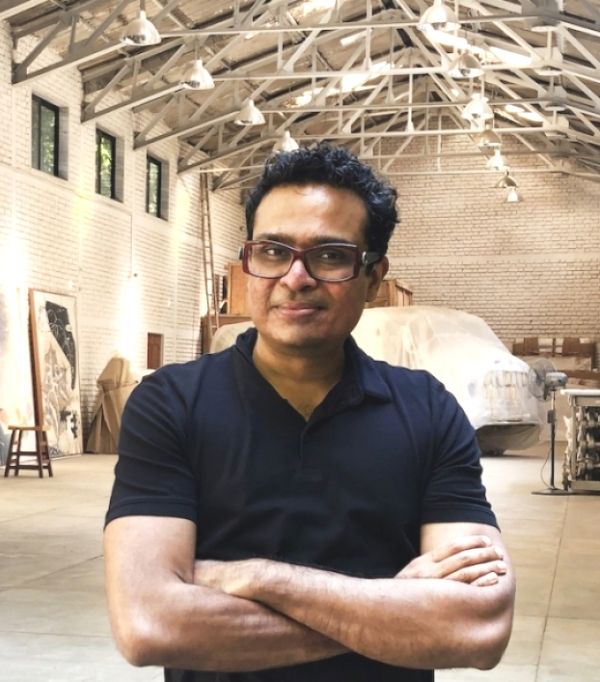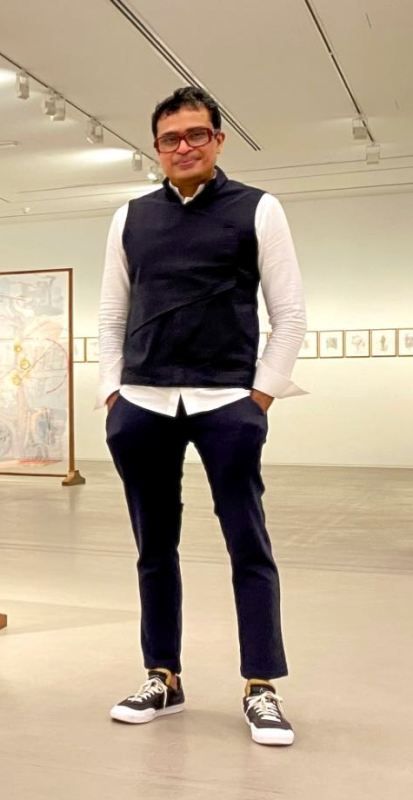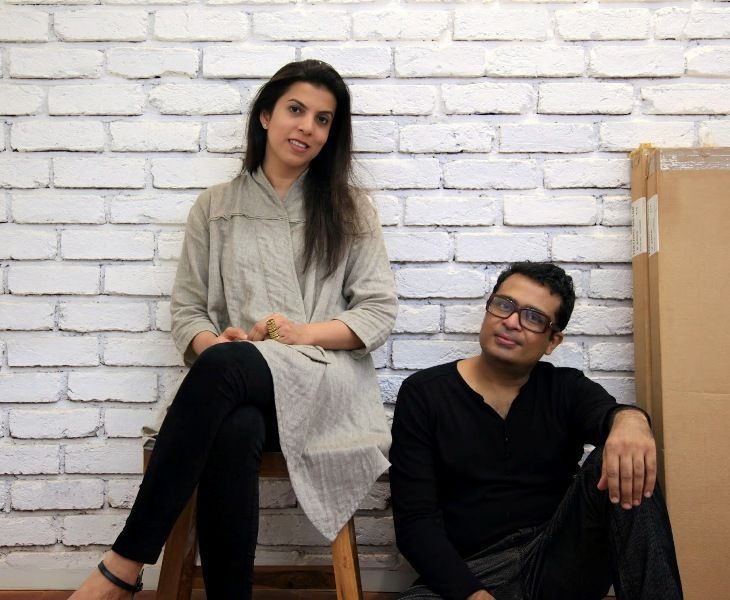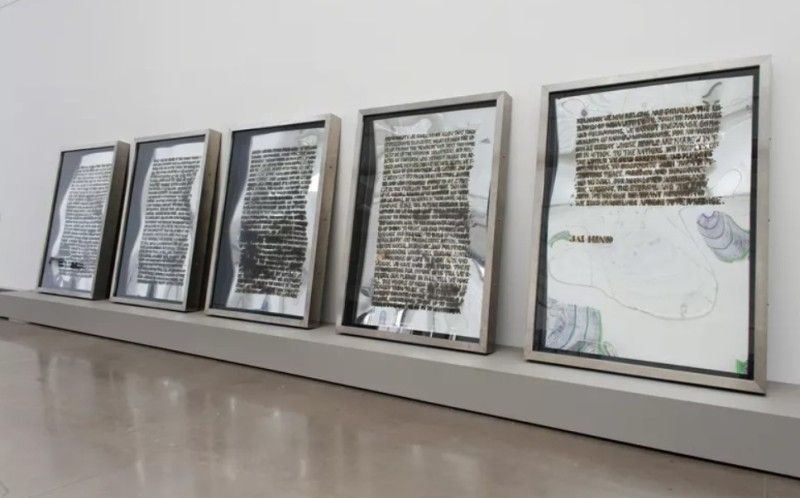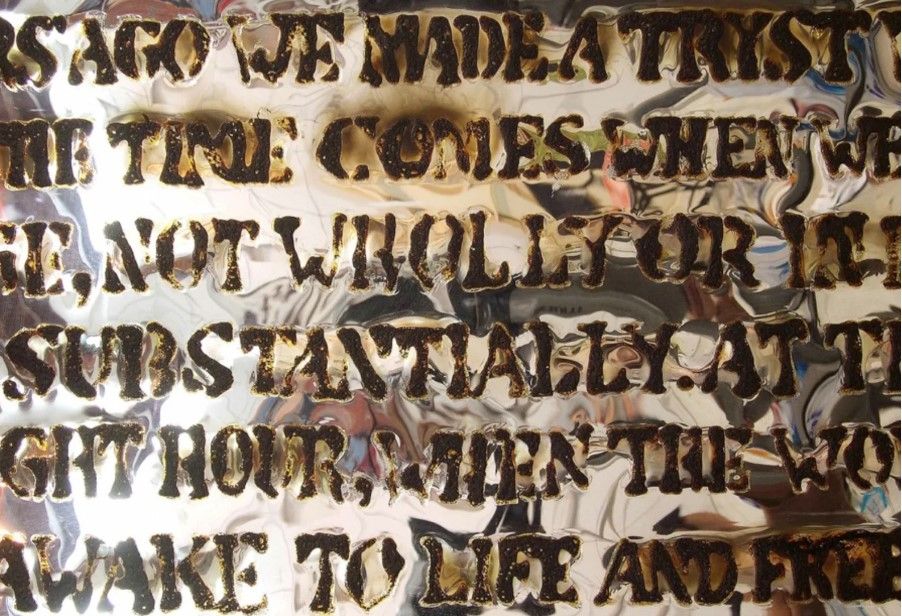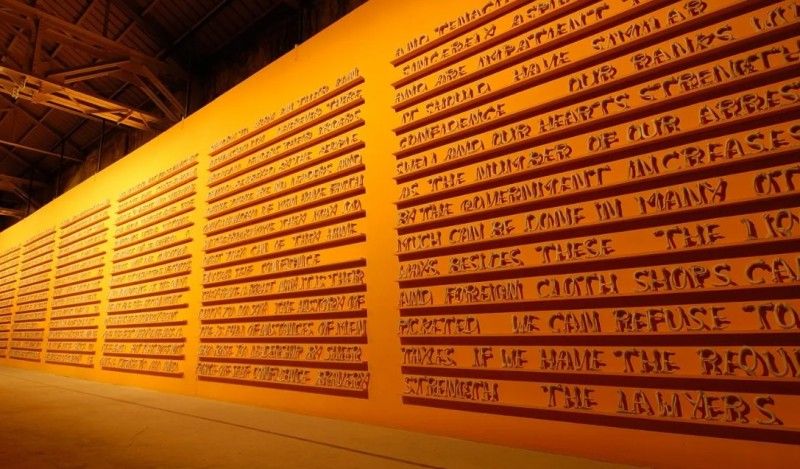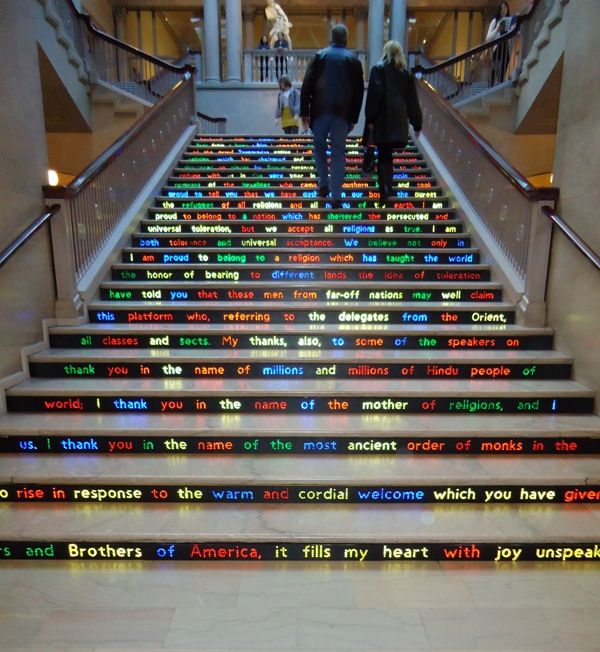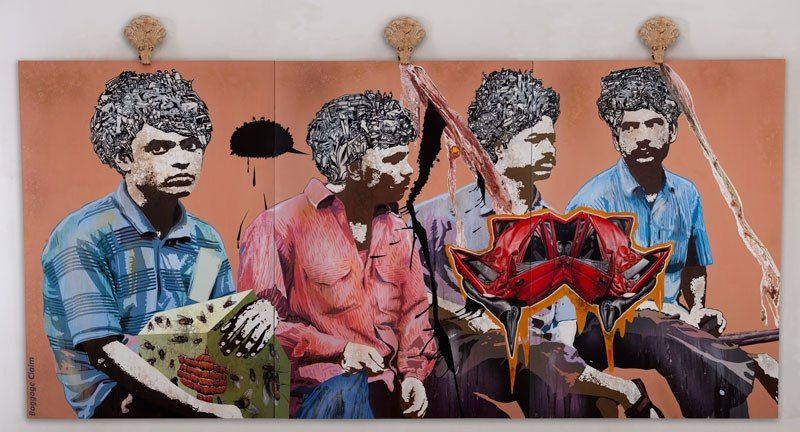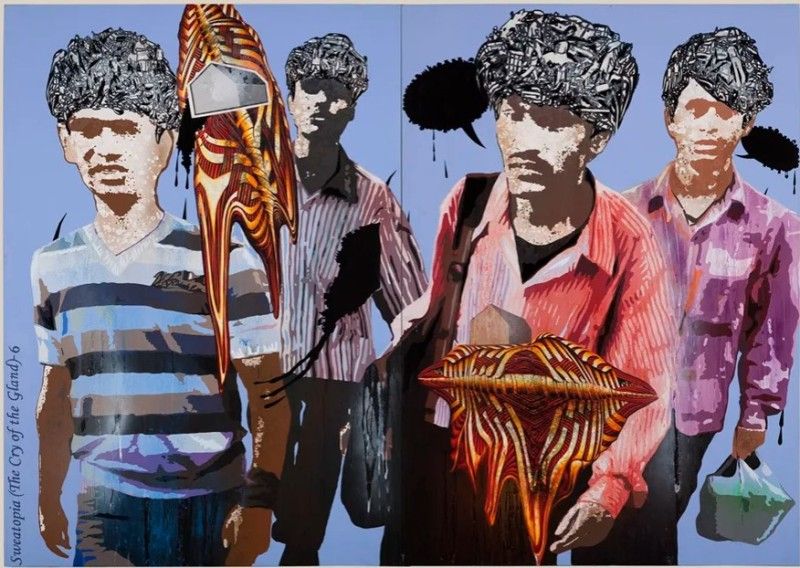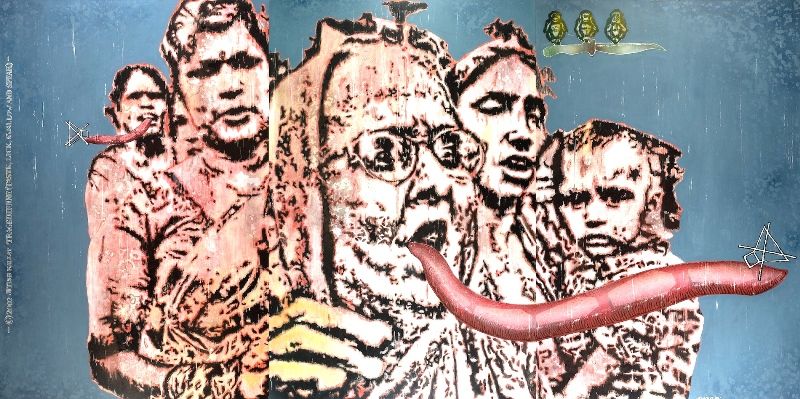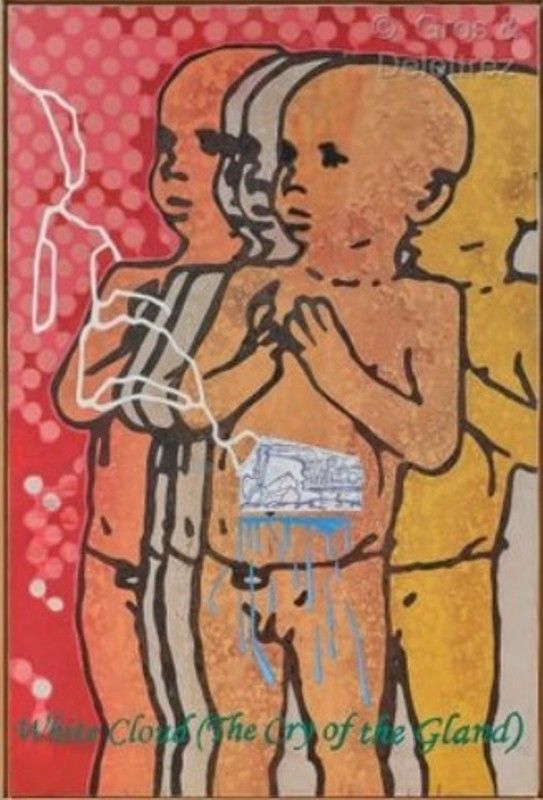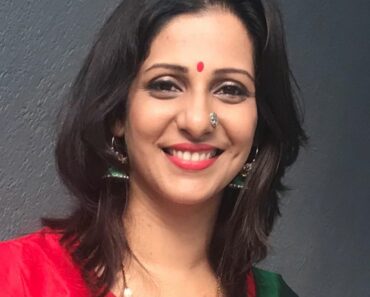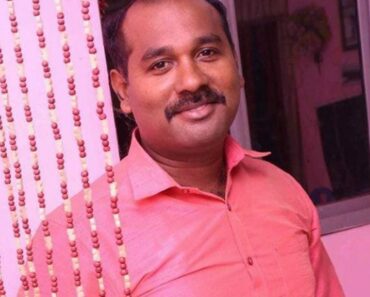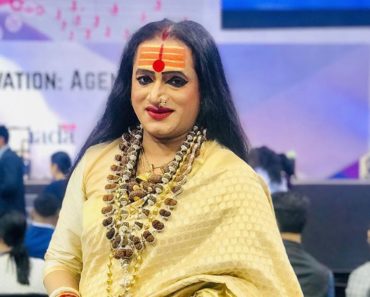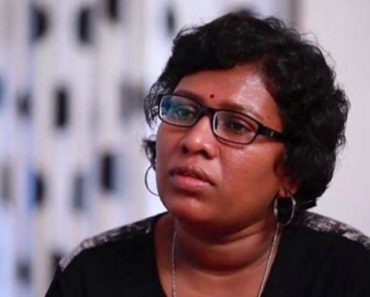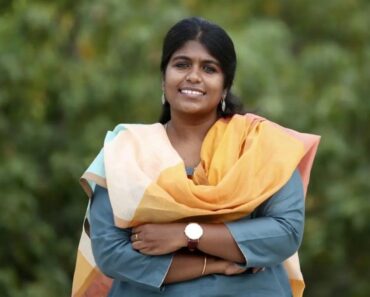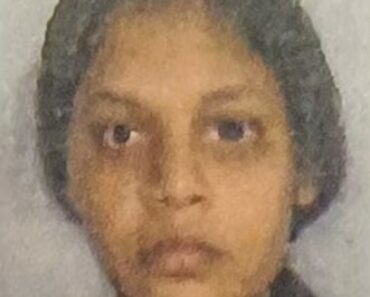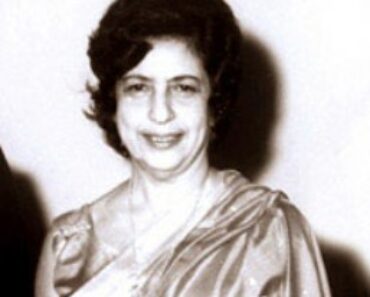Jitish Kallat is an Indian artist known for his artworks, which include sculptures, paintings, installations, photography, and multimedia works. His artworks reflect the milieu of his birth city, Mumbai. His artworks mainly incorporate the concerns like India’s striving to enter a globalized economy, tackling the crises related to housing and transportation, city planning, caste and communal tensions, and government accountability. In 2014, he became the Artistic Director of the second edition of the Kochi-Muziris Biennale, held in Kochi. Kallat’s artworks are represented by the most famous art galleries and exhibitions like Nature Morte, New Delhi, Chemould Prescott Road, Mumbai, ARNDT, Berlin, and Galerie Daniel Templon in France and Belgium.
Contents
Wiki/Biography
Jitish Kallat was born in 1974 (age 48 years; as of 2022) in Mumbai, India. In 1996, he received a bachelor’s degree in Fine Arts in painting from the Sir JJ School of Arts in Mumbai.
Physical Appearance
Height (approx.): 5′ 9″
Hair Colour: Black
Eye Colour: Black
Family
Parents & Siblings
There is not much information available about his parents and siblings.
Wife
He is married to Reena Saini who is also a renowned artist.
Famous Artworks
After graduating in 1996, Kallat had his first solo exhibition titled “PTO” at Chemould Prescott Road.
Installations
Public Notice (2003)
The first work in the Public Notice art series by Jitish Kallat was created in 2003. In this installation, Kallat evoked the notable ‘Tryst with destiny’ speech delivered by Jawaharlal Nehru on 14 August 1947, on the eve of India’s independence, at the Red Fort, Delhi. The installation incorporates five art pieces, and to make these art pieces, Kallat hand-inscribed the speech using rubber glue on acrylic panels to make letters and then flamed them to give a burnt texture. The use of burnt words to inscribe Nehru’s speech in this artwork expresses the failure of what Nehru wanted to convey through this speech. The mirrors used by him in his installation give a distorted reflection. Through this installation, Kallat made a political statement against the massacre of the Godhra Riots in Gujarat in February 2002. While talking about this art, he said,
The words are cremated… much as the content of the speech itself was distorted by the way the nation has conducted itself in the last six decades.”
Public Notice 2 (2007)
“Public Notice 2” is the second work in the art series “Public Notice” by Jitish Kallat. The art piece evokes the memorable speech delivered by Mahatma Gandhi at Sabarmati Ashram on 11 May 1930, a day before starting the ‘Dandi March,’ against the British laws of imposing taxes on the production of salt in India. It was a non-violent civil disobedient movement in which Mahatma Gandhi and his troop covered approximately the distance of 385 km in 24 days. In his speech, Gandhi made a plea to his fellow revolutionaries to maintain peace and absolute non-violence. Kallat, in this work, used 4500 bone-shaped resin letters to inscribe Gandhi’s speech. The use of bone shapes in letters by Kallat symbolises the relic that holds the history of people’s aggression, whereas the speech is all about an appeal for peace and non-violence. The idea behind incorporating Gandhi’s speech in his artwork was that Kallat wanted to make people recall the promises of nonviolence. In an interview, while talking about this, Kallat said,
In today’s terror-infected world, where wars against terror are fought at prime television time, voices such as Gandhi’s stare back at us like discarded relics.” [1]Saatchi Gallery
The art historian Chaitanya Sambrani wrote in his essay, entitled “Of Bones and Salt: Jitish Kallat’s Public Notice 2,”
The act of rehearsing a text from modern history and meditating on its relevance today is charged with a revisionary historicism: Kallat simultaneously places the text within its particular historical moment and reinvigorates it for present purposes.”
Public Notice 3
The third artwork of the Public Notice series by Jitish Kallat links two important events of history, i.e., the First World Parliaments of Religions, held in September 1893, and the terrorist attacks on the World Trade Center and the Pentagon in September 2001. In Public Notice 3, Kallat re-invoked the speech delivered by Swami Vivekanand that he delivered at the World Parliament of Religions in 1893 while representing Hinduism. The artwork was exhibited at the ‘Grand Staircase of Art Institute of Chicago’ on 11 September 2010, on the same date and place where the speech was actually delivered by Swami Vivekanand. Kallat made use of LED bulbs of five different colours, consisting of red, orange, yellow, blue and green, for making this art piece. [2]Jitish Kallat
Paintings
What makes his paintings unique from others is his use of icon-liked images that float around the protagonist in his paintings. His paintings are usually narrative and abstract. He creates a weathered texture for his paintings that reflects the grittiness and messiness of his city, Mumbai. Talking about the texture of his paintings in an interview, he said,
I would peel off paint in places to reveal the white canvas so that in the end you have a new painting that looks old, like the passing of time.’ [3]Apollo
Some of his famous paintings include Baggage Claim (2010), Sweatopia (The Cry of the Gland) 6, (2010), Tragedienne (Taste, Lick, Swallow and Speak), White Cloud (The Cry of the Gland), Active Desktop (2002), Rickshawpolis (2005), and many more.
Themes
The depiction of the urban milieu of Mumbai in his artworks reflects his deep attachment to the city. He portrays issues in the country such as India’s striving to enter a globalized economy, tackling the crises related to housing and transportation, city planning, caste and communal tensions, and government accountability in his artworks. He presents the downtrodden or dispossessed inhabitants of Mumbai in a bold, colourful, and highly graphic manner. Usually, Kallat creates his paintings on bronze sculptures that are re-created from the wall adornments found on the 120-year-old Victoria Terminus train station in the centre of Mumbai. His large-sized paintings are based on the theme of self-centred open narrative and are related to the ideas of time, death, cycles of life, celestial references, and familial ancestry. The distinct feature of his painting style is that he textured his canvas art piece in such a way that it seems old and weathered. It appears as if the paintings were left under the sky to be damaged by the changing weather like rains and scorching sun. Earlier his subject matter was described as ‘the dirty, old, recycled and patched-together fabric of urban India.’ In an interview, while talking about the theme of his art, Jitish Kallat quoted,
The city street is my university. One finds all the themes of life and art – pain, happiness, anger, violence and compassion – played out here in full volume. Scale is merely one of the many tools one can deploy in the creation of meaning, and decisions such as big, small, lifesize, etc., are as much acts of meaning creation as they may be retinal or aesthetic considerations.” (feb 2010)
Exhibitions
Solo Shows
- “P.T.O.,” at Gallery Chemould and Prithvi Gallery in Mumbai, India (1997)
- “Apostrophe,” India Habitat Centre at New Delhi, India (1998)
- “Private limited I,” at Bose Pacia Modern in New York, USA and “Private limited II,” at Apparao Gallery in Chennai, India (1999)
- “Ibid.” at Gallery Chemould in Mumbai, India (2000)
- “Milk Route” at India Habitat Centre in New Delhi, India and “General Essential” at Sakshi Gallery in Bangalore, India (2001)
- “First Information Report” at Bose Pacia Modern in New York, USA (2002)
- “The Lie of the Land” at Walsh Gallery in Chicago, USA (2004)
- “Rickshawpolis 1” at Nature Morte in New Delhi, India, “Panic Acid” at Bodhi Art in Singapore, and “Humiliation Tax” at Gallery Chemould in Mumbai, India (2005)
- “Rickshawpolis 2” at Spazio Piazza Sempione in Milan, Italy (2006)
- “Sweatopia” at Chemould Prescott Road and Bodhi Art in Singapore, “Unclaimed Baggage” at Albion in London, UK, “365 Lives” at Arario Gallery in Beijing, China, and “Rickshawpolis 3” at Gallery Barry Keldoulis in Sydney, Australia (2007)
- “Aquasaurus” at Sherman Contemporary Art Foundation in Sydney, “Skinside Outside” at Arario Gallery in Seoul, South Korea, “Public Notice 2” Bodhi Art in Singapore, and “Universal Recipient” at Haunch of Venison in Zurich, Switzerland (2008)
- “Public Notice 3” Curated by Madhuvanti Ghosh at the Art Institute of Chicago in Chicago, USA, “Likewise” at ARNDT in Berlin, Germany, and “The Astronomy of the Subway” at Haunch of Venison in London, UK (2010)
- “Fieldnotes: Tomorrow was Here Yesterday” at Dr. Bhau Daji Lad Museum in Mumbai, India, and “Stations of a Pause” at Chemould Prescott Road, Mumbai, India (2011)
- “Circa” Curated by Natalie King, Bala Starr and Andrew Jamieson, Ian Potter Museum of Art in Melbourne, Australia, and “Chlorophyll Park” at Nature Morte in New Delhi, India (2012)
- “The Hour of the Day of the Month of the Season” at Galerie Daniel Templon in Paris, France “Epilogue” Curated by Susan Leask and Jodi Throckmorton at San Jose Museum of Art, USA (2013)
- “Public Notice 2” Curated by Suhanya Raffel, Presented by Sherman Contemporary Art Foundation, Art Gallery of New South Wales, Sydney, Australia, and “The Infinite Episode” Galerie Daniel Templon in Paris, France (2015)
- “Covering Letter,” Curated by Amanda Sroka at Philadelphia Museum of Art in Philadelphia, USA, “Covering Letter,” Curated by Kamini Sawhney at Chhatrapati Shivaji Maharaj Vastu Sanghralaya in Mumbai, India, and “Sightings” at Chemould Prescott Road in Mumbai, India (2016)
- “Covariance” at Galerie Daniel Templon in Brussels, Belgium, and “Here After Here” (1992-2017), Curated by Catherine David at the National Gallery of Modern Art in New Delhi, India (2017)
- “Decimal Point” at Sperone Westwater Gallery in New York, USA (2018)
- “Phase Transition” at Galerie Templon in Paris, France (2019)
- “Return to Sender” at Frist Art Museum in Nashville, USA, “Terranum Nuncius” at Famous Studios at Mumbai, India, and “Terranum Nuncius” at Bikaner House in New Delhi, India (2020)
- “Epicycles” at Norrtalje Konsthall in Sweden (2021)
Selected Group Exhibitions
1997
- Innenseite, Curated by Hamdi El Attar, Projektgruppe Stoffwechsel, University of Kassel, Germany
- 50 Years of Art in Mumbai, Curated by Saryu Doshi, National Gallery of Modern Art, Mumbai, India
1998
- Art of the World 1998, Passage de Retz, Paris, France
1999
- The First Fukuoka Asian Art Triennale, Curated by Kuroda Raiji, Fukuoka Asian Art Museum, Japan
2000
- Seventh Havana Biennale, Curated by Hilda Maria Rodriguez, Havana, Cuba
2001
- Century City: Art and Culture in the Modern Metropolis, Curated by Geeta Kapur and Ashish Rajadhyaksha, Tate Modern, London, UK
- Indian Painting, Curated by Haema Sivanesan, Art Gallery of New South Wales, Sydney
- Palette 2001, Palette Art Gallery, New Delhi, India
2002
- Under Construction, Curated by Ranjit Hoskote, The Japan Foundation, Asia Center, Tokyo
- India, Contemporary Art from Northeastern Private Collection, Curated by Jeffrey Wechsler, Jane Voorhees Zimmerli Art Museum, New Jersey, USA
2003
- SubTerrain: Artists Dig the Contemporary, Curated by Geeta Kapur, House of World Cultures, Berlin
- Pictorial Transformations, National Art Gallery, Kuala Lumpur, Malaysia
- Crossing generations: diVERGE, Curated by Geeta Kapur and Chaitanya Sambrani, National Gallery of Modern Art, Mumbai, India
2004
- Zoom! Art in Contemporary India, Curated by Nancy Adajania and Luis Serpa, Culturgest, Lisbon
- Contemporary Art From India, Thomas Erben Gallery, NY, USA
- Summer Show, Bose Pacia Gallery, NY, USA
2005
- First Pocheon Asian Art Triennale, Curated by Yoon Jin Sup, Pocheon, Korea
- Indian Summer, Curated by Henri Claude and Deepak Anath, Ecole Nationale Supérieure des Beaux-Arts, Paris, France
- The Artist Lives and Works in Baroda/Bombay/Calcutta/Mysore/ Rotterdam/Trivandrum, House of World Cultures, Berlin, Germany
2006
- The 6th Gwangju Biennale, Curated by Kim Hong-hee, Wu Hang and Kim Sang-Yun, Korea
- The 5th Asia Pacific Triennial of Contemporary Art, Brisbane, Australia
- Passages, Curated by Deepak Ananth and Jany Lauga, Palais des Beaux Arts, Brussels
2007
- Soft Power: Asian Attitude, Curated by Biljana Ciric, Huangfu Binghui, Shen Qibin, Shanghai Zendai Museum of Art, Shanghai, China
- Urban Manners, Curated by Adelina von Furstenberg, Pirelli Hangar Bicocca, Milan
- Hungry God, Art Gallery of Ontario, Toronto
2008
- Farewell to Post Colonialism, Curated by Gao Shiming, Sarat Maharaj, Chang Tsong-zung, The 3rd Guangzhou Triennial, Guangdong
- Museum of Art, Guangzhou, Guangdong, China
- Indian Highway, Curated by Julia Peyton-Jones, Hans-Ulrich Obrist, Thierry Raspail, Serpentine Gallery, London, UK
- Die Tropen: Views from the Middle of the Globe, Curated by Alfons Hug, Dr Peter boy, Prof. Dr Viola King, Martin-Gropius-Bau, Berlin, Germany
2009
- India Contemporary, Curated by William Baars, Gemeentemuseum Den Haag, Hague, Netherlands
- Mythologies, Haunch of Venison, London, UK
- Chalo! India: A New Era of Indian Art, Curated by Akiko Miki, National Museum, Seoul and Essl Museum, Vienna, Australia
- Art Foundation Mallorca Collection, Centro Cultural Andratx, CCA Andratx, Spain
2010
- Monumental, Walsh Gallery, Chicago, USA
- Collection Show 2010, Arario Gallery, Seoul, South Korea
- Now Through a Glass Darkly, Arario Gallery, NY, USA
- Changing the World, ARNDT, Berlin, Germany
2011
- Boundaries Obscured, Haunch of Venison, NY, USA
- Paris- Delhi- Bombay, Center Pompidou, Paris, France
- Pause: A collection, Sakshi Gallery, Mumbai, India
2012
- Arsenale 2012, The First Kiev International Biennale of Art, Curated by David Elliott, Kiev, Ukraine
- India: Art Now, ARKEN Museum of Modern Art, Ishøj, Denmark
- Critical Mass: Contemporary Art from India, Curated by Tami Katz-Frieman and Rotem Ruff, Tel Aviv Museum of Art, Tel Aviv, Israel
2013
- Curitiba Biennial, Curated by Stephanie Dahn Batista, Angelo Light, Deborah Santiago, Kamilla and Renan Araujo Nunes, Curitiba, Brazil
- Ideas of the Sublime, Curated by Gayatri Sinha, Vadehra Art Gallery, New Delhi
- Aesthetic Bind |Citizen Artist: Forms of Address, Curated by Geeta Kapur, Chemould Prescott Road, Mumbai, India
2014
- Busan Biennale 2014: Inhabiting the World, Artistic Director- Olivier Kaeppelin, Busan, South Korea
- An Appetite for Painting, Contemporary Painting 2000–2014, Curated by Gavin Jantjes, The Museum of Contemporary Art,
- Architecture and Design, Oslo, Norway
2015
- After Midnight: Indian Modernism to Contemporary India 1947/1997, Curated by Dr Arshiya Lokhandwala, Queens Museum of Art, New York
- After Utopia, Curated by Tan Siuli and Louis Ho, Singapore Art Museum, Singapore
- Obsession, Maison Particulière, Brussels, Belgium
2016
- Given Time: The Gift and its Offerings, Curated by Arshiya Lokhandwala, Gallery Odyssey, Mumbai
- Setouchi Triennale, Curated by Fram Kitagawa, Takamatsu, Japan
- Telling Tales: Excursions in Narrative Form, Curated by Rachel Kent, Museum of Contemporary Art, Sydney
2017
- India Re-worlded: Seventy Years of Investigating a Nation, Curated by Arshiya Lokhandwala, Gallery Odyssey, Lower Parel, Mumbai
- Age of Terror, Curated by Sanna Moore, Imperial War Museum, London, UK
- A World in the City: Zoological and Botanic Gardens, Curated by Kaiwan Mehta, IFA Stuttgart, Germany
2018
- Asia Pacific Breweries Foundation Singapore Art Prize 2018 Exhibition, Singapore Art Museum, Singapore
- Riots: Slow Cancellation of the Future, Curated by Natasha Ginwala, ifa Galleries, Berlin and Stuttgart
- Asymmetrical Objects, Curated by Tasneem Mehta and Himanshu Kadam, Dr Bhau Daji Lad Museum, Mumbai, India
2019
- Our Time for a Future Caring, Curated by Roobina Karode, India Pavilion at the Venice Biennale, Venice, Italy
- Circadian Rhythms: Contemporary art and biological time, Curated by Chris Clark and Fiona Kearney, The Glucksman, Cork, UK
- Weather Report, Curated by Richard Klein, Aldrich Museum of Art, USA
2020
- Chromatopia, Art Gallery of Southern Australia, Australia
- South East North West, Curated by Rory Padeken, San Jose Museum of Art, San Jose, USA
- Distorted Portrait, Space k Seoul, South Korea
2021
- Frieze Art Fair, London, UK, Presented by Nature Morte
- Markers of Time and Space, Nature Morte, New Delhi, India
- Confabulation, Nature Morte, New Delhi, India
- On-Site, Bikaner House, New Delhi
Comments on his Artworks
- The co-director of Nature Morte and a noted artist, Peter Nagy praised the art of Jitish Kallat and wrote in his essay titled “Jitish Kallat: 21st Century Boy,”
Other indigenous painters before him had flirted with international styles such as Pop (most notably Jyothi Bhatt and Bhupen Khakhar ) and the mix and match of Postmodernism (namely Gulammohammed Sheikh and Atul Dhodiya), but no one had turned the textures and surfaces of urban India into the fracture of painting quite so successfully,”
- In her book “A Guide to 101 Modern & Contemporary Indian Artists,” Amrita Jhaveri wrote,
Using images from newspapers and magazines, advertising billboards, wallpaper and graffiti, his works are richly layered and replete with metaphor. Kallat has reinvented the painted surface to mimic the appearance of a television still or a computer monitor, complete with its surface striations and auras.“
- The themes of Kallat’s artworks, reflect his encounters with the multi-sensory environment of Mumbai and the economic, political and historical events that have contributed to its making. Remarking on the theme of Kallat’s artwork, the art historian Chaitanya Sambrani wrote,
His practice as painter has frequently highlighted a concern he shares with the founders of Indian modernism in visual and literary art. Kallat has couched his references to the “underdog” in a hyper-pop language in order to signal the ironies that attend the lives of migrant workers and menial labourers in India’s megacities: people met on “second class” train compartments, people whose labour continues to keep afloat the nation’s aspirations. In his installation and video practice, he has often revisited archival texts and museum displays with a view to probing the production and dissemination of knowledge.”
Awards, Honours, Achievements
- He was honoured with the K.K. Hebbar Art Foundation Award in 1996.
- He won Govt. First Prize, Sir J.J.School of Art, Mumbai, India in 1996.
- He was also presented with the ‘Indo-American Society’s ‘Young Achiever Award’ in 2001.
- Kallat was honoured with the ‘Sanskriti Award’ in 2001 and ‘Harmony Award’ in 2002.
Facts/Trivia
- In an interview, while talking about his art, Jitish Kallat compared it with a researcher’s project and said,
My art is more like a researcher’s project who uses quotes rather than an essay, with each painting necessitating a bibliography.”
- In an interview, while talking about the depiction of his city in his paintings in a weathered way, he said,
I am meditating on life and death in the city. Any city we live in is a little window through which we seek the truth. It’s the only choice we have, our own tunneled vision of the world.”
- In 2012, Kallat’s project “Field Notes, (Tomorrow was here yesterday) (2011)” at the Dr Bhau Daji Lad Museum, Mumbai, was selected for The Skoda Prize.
References
| ↑1 | Saatchi Gallery |
|---|---|
| ↑2 | Jitish Kallat |
| ↑3 | Apollo |

